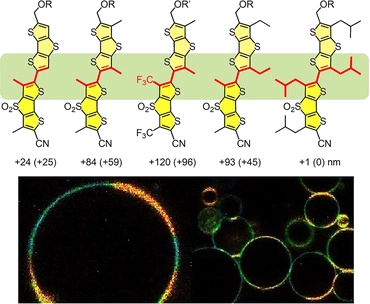- Strakova, K.; Poblador-Bahamonde, A. I.; Sakai, N.; Matile, S. “Fluorescent Flipper Probes: Comprehensive Twist Coverage” Chem. Eur. J. 2019, 25, 14935-14942

To image the membrane tension in living cells, planarizable push–pull probes have been introduced. The first operational probe is built around two dithieno[3,2-b:2′,3′-d]thiophenes (DTTs) that are twisted out of co-planarity and polarized with donors and acceptors at either end. In this report, the chemical space available for the twisting of “flipper probes” is assessed comprehensively. The result is, not surprisingly, that every atom matters: Removal of one methyl group in the twist region yields probes that planarize already in solution and are thus less sensitive to membrane tension. Addition of one or more carbons in the same region hinders non-interfering probe alignment along lipid tails and thus partitioning into lipid bilayer membranes as well as mechanosensitivity. However, substitution of one methyl by an isosteric trifluoromethyl group in the twist region, achieved by quite substantial multistep organic synthesis, yields excitation maxima that shift over +100 nm to the red in response to increasing order of the surrounding membrane. This record redshift comes with record changes in fluorescence intensity and lifetime, high push–pull transition dipoles and higher rotational barriers. Supported by distinct dependence on viscosity and twist of the push–pull probes, kinetic competition between dark, fully twisted and bright, fully planarized relaxed excited states emerges as unifying origin of fluorescence quantum yields.
open archive unige:126804 • pdf ![]()
